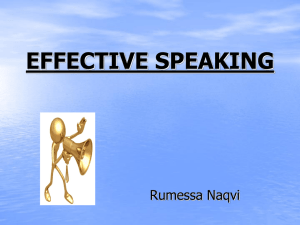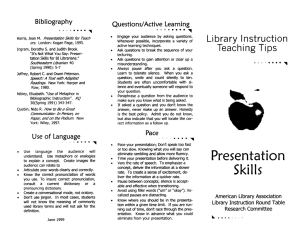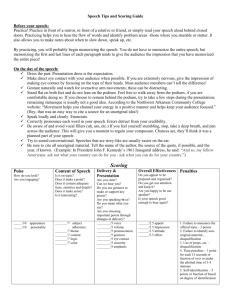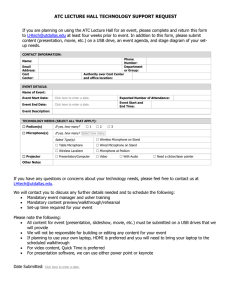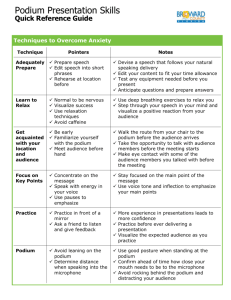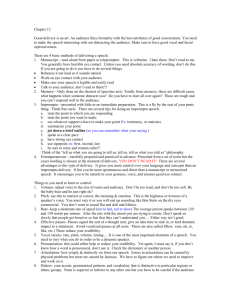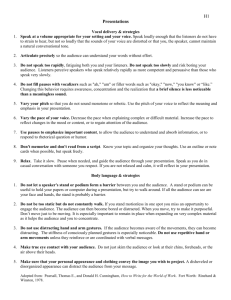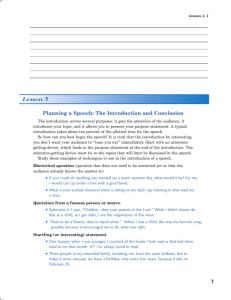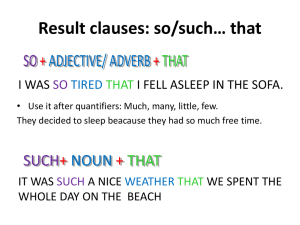Pointers for Public Speakers
advertisement
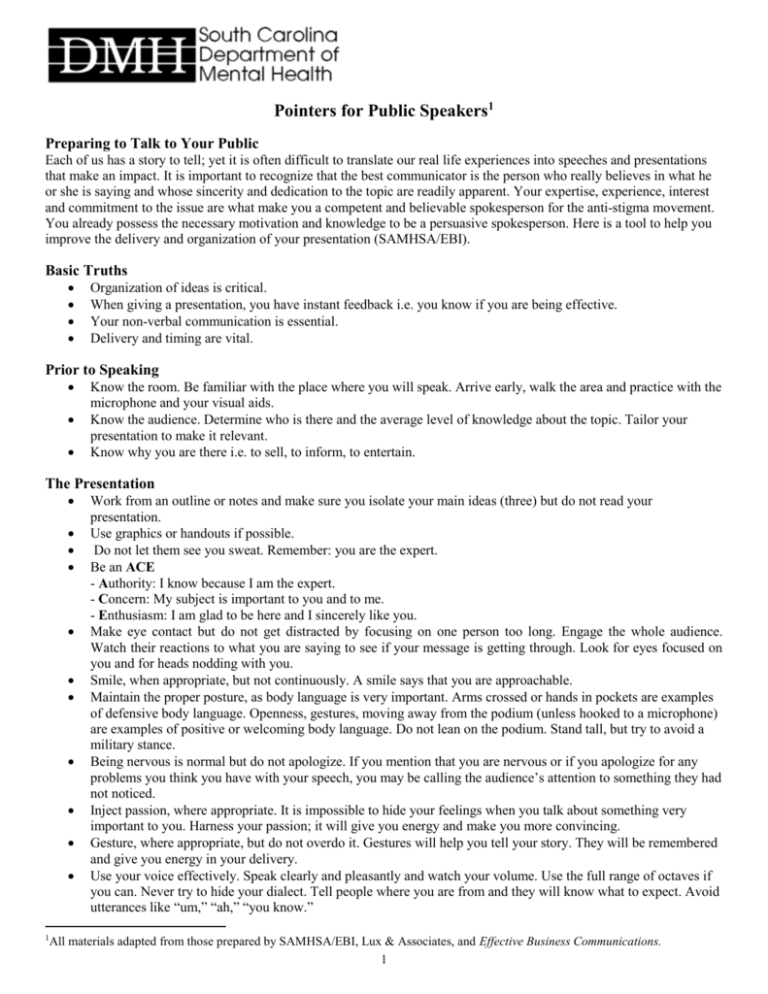
Pointers for Public Speakers1 Preparing to Talk to Your Public Each of us has a story to tell; yet it is often difficult to translate our real life experiences into speeches and presentations that make an impact. It is important to recognize that the best communicator is the person who really believes in what he or she is saying and whose sincerity and dedication to the topic are readily apparent. Your expertise, experience, interest and commitment to the issue are what make you a competent and believable spokesperson for the anti-stigma movement. You already possess the necessary motivation and knowledge to be a persuasive spokesperson. Here is a tool to help you improve the delivery and organization of your presentation (SAMHSA/EBI). Basic Truths Organization of ideas is critical. When giving a presentation, you have instant feedback i.e. you know if you are being effective. Your non-verbal communication is essential. Delivery and timing are vital. Prior to Speaking Know the room. Be familiar with the place where you will speak. Arrive early, walk the area and practice with the microphone and your visual aids. Know the audience. Determine who is there and the average level of knowledge about the topic. Tailor your presentation to make it relevant. Know why you are there i.e. to sell, to inform, to entertain. The Presentation 1 Work from an outline or notes and make sure you isolate your main ideas (three) but do not read your presentation. Use graphics or handouts if possible. Do not let them see you sweat. Remember: you are the expert. Be an ACE - Authority: I know because I am the expert. - Concern: My subject is important to you and to me. - Enthusiasm: I am glad to be here and I sincerely like you. Make eye contact but do not get distracted by focusing on one person too long. Engage the whole audience. Watch their reactions to what you are saying to see if your message is getting through. Look for eyes focused on you and for heads nodding with you. Smile, when appropriate, but not continuously. A smile says that you are approachable. Maintain the proper posture, as body language is very important. Arms crossed or hands in pockets are examples of defensive body language. Openness, gestures, moving away from the podium (unless hooked to a microphone) are examples of positive or welcoming body language. Do not lean on the podium. Stand tall, but try to avoid a military stance. Being nervous is normal but do not apologize. If you mention that you are nervous or if you apologize for any problems you think you have with your speech, you may be calling the audience’s attention to something they had not noticed. Inject passion, where appropriate. It is impossible to hide your feelings when you talk about something very important to you. Harness your passion; it will give you energy and make you more convincing. Gesture, where appropriate, but do not overdo it. Gestures will help you tell your story. They will be remembered and give you energy in your delivery. Use your voice effectively. Speak clearly and pleasantly and watch your volume. Use the full range of octaves if you can. Never try to hide your dialect. Tell people where you are from and they will know what to expect. Avoid utterances like “um,” “ah,” “you know.” All materials adapted from those prepared by SAMHSA/EBI, Lux & Associates, and Effective Business Communications. 1 (The Presentation, cont.) Use the pause and silence when appropriate, e.g.: - When making transitions (going from one subject to another) - When you want the message to sink in - When you need to collect your thoughts - When you receive laughter or applause. Use of humor or jokes is okay, if appropriate, but be careful with this; what is funny to me may not be funny to you, so choose material with care. Avoid distractions such as tugging at your hair, shuffling, jingling change in your pocket, playing with your glasses. Personalize your story by sharing your information up front. Practice but practice perfectly. Perfect practice will result in a perfect presentation. The Process Introduction (15%) - Greet them, ad lib - State your purpose - State your plan of presentation (usually three points) - Tell a story or give background - Startle them - Ask a question that has an obvious answer - Give a familiar quote - Try a joke - Give a startling statistic - Refer to the subject, its timeliness, its importance - Refer to the occasion Body (75%) - Lead the audience by using transitions, such as enumeration (first, second, etc) - Use visual aids to support your point such as Power Point (do not read the slides to them) - Face the audience and do not block the screen - Use notes but do not read them - Watch the crowd for its reaction - Remember the tips about delivery (voice, movement, etc) Conclusion (10%) - Two sweet words: “In conclusion…” - May end with a story that illustrates your point - May summarize - Do not raise a new point Recap Prepare well: perfect practice makes perfect presentations. Memorize your opening sentence. Have something physical e.g. slides. Move around to reduce tension, change a point or secure audience reaction. Have the right attitude…like the audience, be sincere, and give them something to think about, secure their buy in. Be an ACE. After Your Presentation If someone asks you a question you are unable to answer or if you are not sure of the answer, then say so. Get the person’s name and say that you will get the information to him or her. Gain experience. Experience builds confidence, which is one of the keys to effective public speaking. 2
